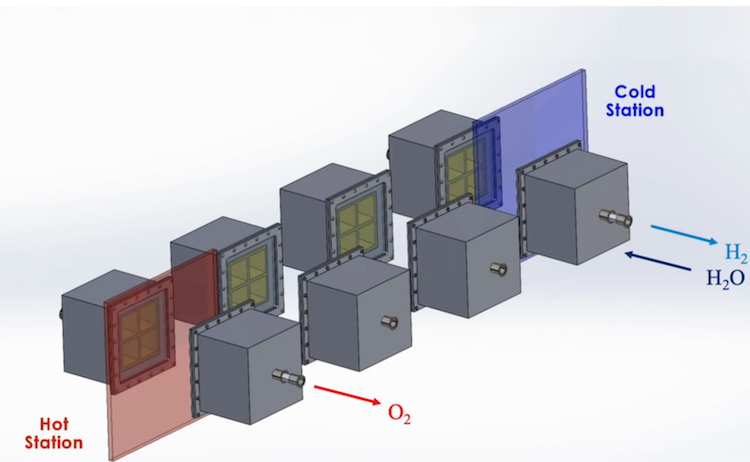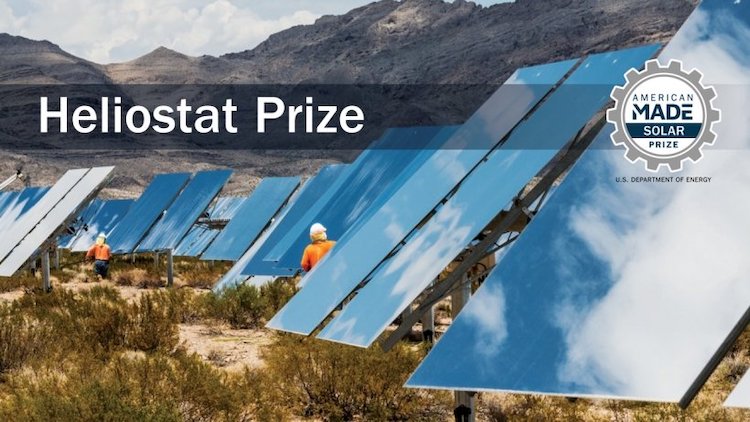
Carbon sequestration in mining waste over the past 50 years can be seen at BPH Group’s Australian nickel mine at Mt Keith. The mineral wastes have weathered and become bluer and then whiter, indicating the changed chemical composition as it sequesters CO2.
Australian researchers propose using solar power to capture and store carbon in mining waste. They are doing the first techno-economic assessment and emission analysis of using concentrated solar heat for serpentine activation to produce activated feedstock materials for carbon capture, utilisation and storage (CCUS) processes via mineral carbonation.
Carbon sequestration of mining waste mimics natural carbonation in rocks
In the natural process of silicate weathering, carbon dioxide is very gradually and permanently sequestered in environmentally benign carbonates and silica rocks. Carbon dioxide in the air reacts with naturally occurring oxides or silicates of magnesium, iron, and calcium to form these stable carbonates, locking the carbon dioxide in permanently on a geological time scale.
But over the last 20 years, scientists have found ways to make certain minerals sequester more carbon much faster by forcing the activation of serpentine. Research in the field has accelerated the kinetics, improved the efficiency, and works on scaling up the technology. In Australia, a company that has already achieved pre-commercial scale mineral carbonation, MCi Carbon, is building its mineral carbonation plant in Newcastle.
However, until now, the heat to run this reaction has been supplied using fossil energy. This results in lower capture efficiency because it also has to sequester additional carbon dioxide generated by the burnt fossil fuel.
Solar heat to more efficiently sequester carbon
To make the process more efficient, Australian researchers have now designed and patented a way to heat the reaction with concentrated solar heat (CST) instead.
“We can now basically accelerate the binding between the CO2 and the magnesium or calcium oxide in a matter of hours,” said Alfonso Chinnici, who leads research in concentrated solar engineering at the University of Adelaide. The university encourages practical solar research on decarbonizing its mining industries in Australia.
“We ended up exploring a new way to thermally activate this material, with high flux radiation from concentrated solar thermal. Because it has one key advantage: potentially producing very rapid heating. We are interested in that because by optimizing the material’s swift heating step, we can fine-tune the resulting physical-chemical characteristic of this activated serpentine.”
Their research at Adelaide can improve two aspects of thermal activation of the carbon sequestration process with solar heat.
“Firstly, we can optimize the resulting surface area,” he said. “We can make the material more or less porous. Next, we can optimize the whole heating strategy. We have done several experimental tests examining how heat activation is affected by the fast radiant heating method. There are several advantages to activating the material through fast heating, particularly through solar thermal.”
Unlike many solar thermochemistry processes, the heat requirement is relatively low, about the same as the temperature in today’s CSP (which, like any thermal power production, is limited by the legacy steam power cycle).
“You only need 600°C, maximum 700°C, so it’s no higher than current CSP operation,” Chinnici confirmed.
“You don’t want to go too high with temperature. If you heat this material at a much higher temperature, you start forming very crystalline stable elements, which are detrimental to mineral carbonation. So, you want to heat the material fast enough to activate the material.”
In this study of using solar energy to sequester carbon in mineral deposits, researchers looked at the economics of using concentrated solar heat compared to traditional heating methods using fossil fuels, taking into account the size of the operation and the distance from the mine, to see if this would be practical and effective.
The Mount Keith Nickel mine in Western Australia would be ideal
BHP Group has been considering the potential of capturing and storing carbon using waste from its mining operations in Australia. Together with the Italian engineering company Magaldi, which makes components for CST thermochemistry, it funded a study on thermal pre-treatment of different ores as a direct industry research contract.
“BHP’s Mount Keith Nickel mine in Western Australia is probably the most studied site on the whole globe for active mineral carbonation because you can go on the mine and see mineral carbonation naturally occurring over time because they have million tons of tailings that has been accumulated over the lifetime of the mine,” Chinnici explained.
Chinnici said this mine would be ideal for using solar heat to activate minerals like serpentine for CO2 capture because nickel mining waste is ideal for mineral carbonation.
“You are looking for a waste that has a high content of magnesium or calcium, which is the kind of the key ingredient to basically enable some of this reaction with the carbon dioxide to happen,” he added.
The nickel mining waste at Mt Keith absorbs more CO2 in mineral carbonation than the mine produces. The capacity of those tailings to absorb CO2 is about ten times the mine’s annual emissions. So, this mine is already a carbon sink as it absorbs more than it produces—but over a centuries-long time scale, which has no impact on more immediate human needs to cut carbon much faster.
Green hydrogen to run overnight
To run continuously over night the researchers propose ultimately using the combustion of green hydrogen. Chinnici previously designed and patented a hybrid solar reactor generating hydrogen that runs partly on hydrogen combustion. But the TRL level of his hydrogen-solar reactor technology is 5. Further research is needed to reach the Technology Readiness Level of nine that indicates commercialization readiness.
In the meantime, because most green hydrogen is not yet competitive commercially, the team also costed out an interim option to keep the process running overnight. So to do this they also assessed the cost/benefit of running the process with solar heat by day and using gas only at night.
This hybrid carbon sequestration in mining waste process—using solar by day and gas only at night—would cost about the same as today’s 24-hour gas process, but would have an advantage over 100% fossil process. By generating lower CO2 during the process itself, it would be a more efficient way to cut CO2 emissions via sequestration. Once night operation can be run on green hydrogen, this solar sequestration would have no emissions, for the most efficient technology for rock-based carbon sequestration.
The researchers briefly outlined the concept in the abstract presented at the SolarPACES Conference, Novel Use of Concentrated Solar Thermal Energy for Producing Highly Thermal Activated Materials for CCUS via Mineral Carbonation of Mine Waste marking the first techno-economic assessment and emission analysis of a CST-based heating plant for serpentine activation to produce activated feedstock materials for CCUS processes via mineral carbonation.
Add Hydrogen Combustion to a Solar Reactor for Carbon-Free Mining and Mineral Processing











































